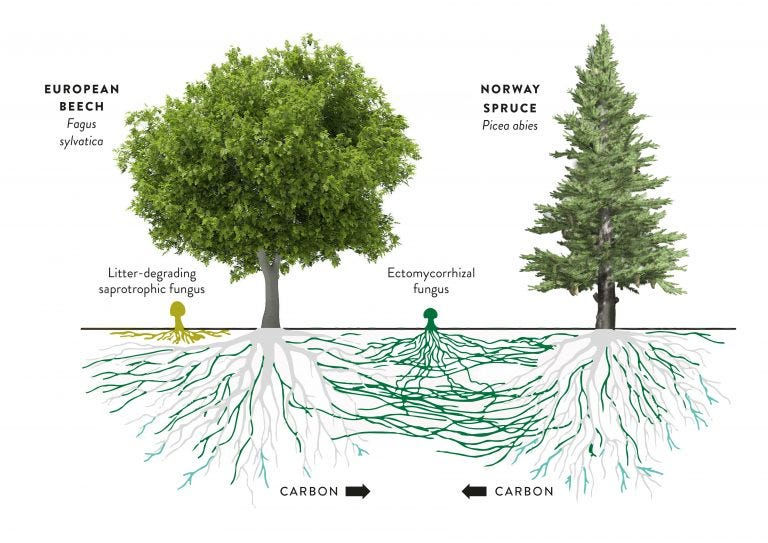How Living Things Store Resources for Survival
- tannerjanesky
- Nov 19, 2024
- 6 min read
What nature can teach us about designing resilient energy systems
In nature, survival often depends on finding creative ways to store resources like water, food, and energy to prepare for periods when these essentials are scarce. By studying how living organisms store and conserve resources like water, food, and energy to survive periods of scarcity, we learn to apply these natural strategies to develop efficient and resilient resource and energy storage systems for human use. We can learn from nature's solutions.
Water Storage Strategies
Succulents and Xerophytes
Desert plants like cacti and other succulents have evolved to thrive in arid environments by storing water in their leaves, stems, and roots. These plants have specialized tissues that hold onto water and release it slowly, allowing them to survive extended droughts. Their leaves are often small or modified into spines to reduce water loss, while the plant surface may be covered in a waxy coating that seals in moisture. By storing water and conserving it through structural adaptations, succulents have evolved to survive where water is scarce.

Just as succulents use specialized tissues to store water, we could explore advanced reservoirs and storage materials that minimize water loss. Innovations like local underground cisterns, water-saving urban landscapes, and things that reduce reservoir evaporation rates can mimic the strategies of succulents to ensure water is available in times of scarcity.
Camels
Camels can go days without drinking because they have oval-shaped red blood cells that can absorb large amounts of water without rupturing. This adaptability allows camels to drink a lot when water is available and retain it in their bloodstream longer. Other desert animals, like kangaroo rats, have evolved efficient kidneys that reclaim water from their waste.
We can develop systems that are designed to handle both long droughts and heavy flooding. Greywater recycling in households and municipalities could allow us to reuse water, reducing the amount we pull from aquifers and rivers.
Tortoises
Some species, like the desert tortoise, have evolved internal water storage sacs that allow them to store water for use during dry periods. These storage sacs are essentially expanded sections of the tortoise's bladder that hold onto water and can reabsorb it as needed, which lets tortoises survive for months without access to fresh water.
This principle could inspire innovations in home rainwater storage systems, allowing people to have access to stored water in the event of drought or water supply interruptions. Individualized water storage tanks or community-level water banks could store water for people in drought-prone areas.
Food and Energy Storage
Animal Fat Storage
Many animals, particularly those that hibernate or migrate, store the energy they need to survive as fat. Fat is a dense source of chemical energy, allowing animals to survive months with little or no food. Bears, for example, accumulate substantial fat reserves before hibernation, which they slowly metabolize during the winter months.

Storing energy for seasonal intermittency is vital for civilization, especially as we transition to renewable energy sources, since much of the world experiences seasons. Long-term energy storage technologies can serve as “fat reserves,” ensuring we have energy during winter months when solar energy is less available.
Plant Carbohydrate Storage
Plants store energy in the form of carbohydrates, typically as starch in their roots, stems, or seeds. Tubers such as potatoes store energy underground, allowing them to survive winter and regrow in the spring. This carbohydrate energy storage protects the plant from seasonal changes and fluctuating conditions like cold temperatures and low sunlight.
Just as plants store carbohydrates, we can take advantage of decentralized energy storage systems that store electricity or other energy forms closer to where it will be used. This can reduce transmission losses and make energy more accessible and reliable in times of peak demand or adverse conditions.
Food Caching by Squirrels
Squirrels and some birds store food in multiple locations to ensure they have enough to eat throughout winter. This caching allows them to distribute and store food, reducing the risk of losing everything if one stash is raided or depleted.

Just as squirrels spread out their food reserves, decentralized energy grids could prevent a single outage from causing widespread impact. Distributed food production can reduce crop loss from bad weather in one region.
Using Resources During Favorable Conditions
Deciduous Trees: Seasonal Resource Use
Deciduous trees drop their leaves and go dormant in winter to reduce water loss and conserve energy. In spring, they use favorable conditions to grow new leaves to capture sunlight and produce carbohydrates again. This seasonal approach allows them to maximize resource use when conditions are ideal and minimize losses during harsher periods.
Seasonal resource allocation could inspire new ways of managing energy consumption. Humans generally require most energy in the winter, primarily for space heating, when solar energy is least available. We could use the relative overproduction of summer solar electricity and store it seasonally for winter heating use. Homes and buildings could be designed to reduce energy needs in the winter, using insulation and smart systems that automatically adjust to seasonal changes.
Leaf Curling in Hot Conditions
Some plants, like grasses, curl their leaves during periods of intense heat or drought to minimize water loss. By reducing the leaf’s surface area exposed to sunlight, they lose less water and stay hydrated even in extreme heat.
This mechanism can influence efficient building designs that reduce heat absorption in summer. Buildings with retractable sunshades or automatic blinds, or windows that change their properties with temperature could mimic the leaf-curling response to reduce cooling costs and energy consumption.
Hibernating Animals and Torpor
Animals like bears and bats enter states of reduced metabolic activity (hibernation or torpor) to conserve energy during times of resource scarcity, such as winter. Lowering their body temperature and heart rate reduces their need for food and water. Hummingbirds do this every night.
Energy demand can also be reduced during off-peak hours or seasons, mimicking the concept of hibernation. Smart appliances and grids can enter “sleep mode” or automatically lower energy usage at night when solar energy isn't available, reducing the need for energy storage.
Preserving Resources by Changing Habits
CAM Photosynthesis
Certain desert plants, such as cacti, open their stomata only at night to capture CO2 by using a unique type of photosynthesis. This CAM photosynthesis separates CO2 uptake from the air and its fixation into sugars. It enables plants in dry environments to minimize water loss while still making sugars efficiently under extreme conditions.
Changing the time of day we use energy or other resources can reduce the total amount required overall.
Nocturnal Animals
Many desert animals, including foxes and rodents, are active at night to avoid the extreme heat of the day. By being nocturnal, they reduce their water needs and avoid dehydration in hot environments.
Changing our habits to align our energy usage with daily cycles can significantly reduce the amount of energy we use. Charging EVs during periods of high renewable electricity production or cooling buildings during the cooler night hours and storing cooling capacity thermally could help lower air conditioning needs during the day and reduce electricity use overall.
Symbiosis: Making Friends
Mycorrhizal Networks and Resource Sharing
Plants and fungi often form mycorrhizal networks, with fungi connecting multiple plants and sharing nutrients between them. This partnership allows plants to access nutrients they would otherwise be unable to reach or use, and the fungi receive sugars from the plants in return. This network also allows deciduous trees to share excess sugars with evergreens during the summer in exchange for sugars in the winter when they're leafless.

Energy-sharing systems like community solar or neighborhood microgrids can create more resilient systems. By creating systems that share resources and take advantage of mutual free trade, we can ensure access to resources even in times of scarcity and ensure infrastructure is fully taken advantage of.
Nitrogen-Fixing Bacteria in Legumes
Legumes host nitrogen-fixing bacteria in their roots, which convert nitrogen from the atmosphere into forms the plants can use. This relationship allows these plants to thrive in soils low in nitrogen, which is necessary for plant growth.
Just as legumes thrive through symbiosis, human communities can benefit from partnerships with energy cooperatives and local producers.
Finding Favorable Resource Conditions
Animal Migration for Resource Access
Many species, from birds to wildebeest, migrate seasonally to follow food, water, and temperature conditions. By moving to areas with favorable resources, they maximize survival and reproduction.
While many ancient human populations were nomadic and followed the animals they relied on for food, the invention of agriculture made us largely stationary and allowed our population to explode. Our vast numbers across the globe now make migration unfeasible, but we can employ planned rotational grazing of animals on agricultural land to improve ecosystem health and yields.
Microclimate and Shelter Building
Burrowing for Stable Microclimates
Burrowing animals create shelters with more stable temperatures and humidity, reducing the need for water and heat to maintain their body temperature.

If we build or modify our homes and buildings to create microclimates that are less energy-intensive to heat and cool, we can reduce energy use. Better insulation, thermal mass, building orientation, and passive solar heating are some examples. Much like a burrow, underground rooms in homes and buildings can maintain stable temperatures with minimal energy input.
It's a requirement for life that organisms store enough energy and water for periods of resource intermittency. Could it be the same for our homes and buildings?
By understanding how nature uses resources and deals with times of scarcity, we can develop our own energy, food, and water systems to reflect natural conditions better. This biomimicry can help us engineer solutions to intermittent resource availability and build a civilization that uses those resources responsibly, resiliently, and sustainably.
Question for you:
Where else can biomimicking nature help us innovate?



Comments